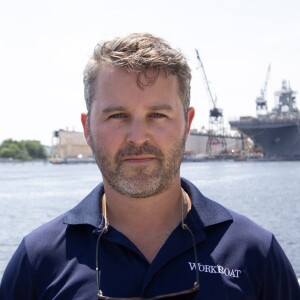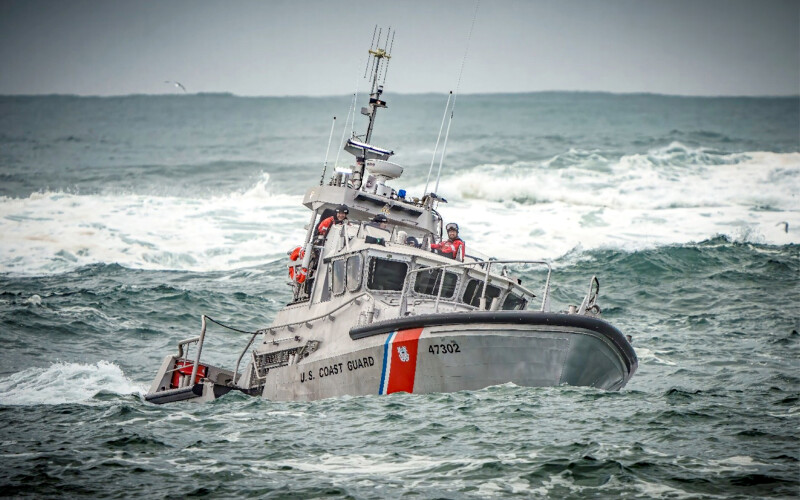U .S. Coast Guard (USCG) Commander Noel Johnson, Chief of the Platform Division in the Office of Boat Forces, opened the International WorkBoat Show’s Military Day with an overview of the USCG fleet and its current requests for proposals.
Johnson was joined by Lieutenant Commander Kara Burns, Deputy of Boat Acquisitions, and Bill Lewis, Contracting Officer. Together, they discussed the current state of USCG boat operations and the latest developments in boat acquisitions, as well as the service’s future procurement needs.
The USCG’s boat forces are integral to the success of its broad mission set. Johnson highlighted that the service operates over 1,700 boats across more than 190 stations, supporting missions from search and rescue to law enforcement, navigation, and environmental protection. Notably, boat forces often outperform other assets in terms of operational frequency, despite aviation and cutters handling more high-profile missions like air rescues.
A key aspect of boat forces, Johnson noted, is their cost-effectiveness. He pointed out that while aviation and cutter fleets demand more funding, boat operations remain a fraction of the cost, making them a vital component of the Coast Guard's overall mission readiness.
Several notable acquisitions were covered in the session, focusing on recent deliveries and partnerships with industry.
22’ Cutter Boat Large: Metalcraft Marine completed the delivery of the 39th and final unit in February 2024. These boats are deployed on the USCG’s 210- and 225-foot cutters, providing multi-mission support.
27’ Special Purpose Craft Shallow Water (SPC-SW): Built by ReconCraft, the 27’ SPC-SW was redesigned with an inboard engine system to reduce its draft to 14”, making it more maneuverable in shallow waters. The USCG received 48 of these units in 2024.
24’ Special Purpose Craft Ice Rescue Transport: These composite boats, built by 1000 Islands Airboat, are designed for ice rescue operations. Two boats are currently on order.
26’ Cutter Boat Over-the-Horizon (OTH): SAFE Boats is delivering the fourth-generation OTH, with 17 boats already delivered and three more expected in 2024. This program serves as a bridge to the next generation, the OTH-5, which will feature improved capabilities.
34’ Long Range Interceptor (LRI-3): This third-generation boat, which deploys from the USCG’s National Security Cutters, extends the reach of these cutters for critical operations. The first LRI-3 is expected to be delivered in December 2024.
36’ Special Purpose Craft Law Enforcement: Built by Silver Ships, this boat is part of a Navy contract that the USCG is leveraging. Twenty-six boats have been ordered, with four already delivered.
36-foot Special Purpose Craft Boarding Team Delivery (SPC-BTD-2): Under a Navy-leveraged contract, the USCG has ordered 12 of these boats, with seven currently planned for delivery by the end of 2024. These boats are essential for Coast Guard boarding operations.
47' Motor Life Boat Service Life Extension Program (SLEP): A key ongoing program to extend the life of the USCG’s 47-foot motor life boats. The service is ramping up production and expects to deliver over 100 boats through this program.
The presentation also provided a glimpse into upcoming boat acquisition programs. While details on some of the new contracts remain confidential, a few high-priority programs were discussed.
Trailerable Aids to Navigation Boat (TANB II) 2nd Generation: The USCG is in the process of recapitalizing its entire fleet of 89 Aids to Navigation boats. The new TANB II boats will feature a more stable design, with hoisting capabilities over the bow to accommodate heavier payloads. The USCG is aiming to finalize the contract soon, with the first new boat expected in early 2025.
Cutter Boat Aids to Navigation Small: This program, which falls under the Waterway Commerce Cutter Program, is designed to replace older boats used for aids to navigation. The USCG plans to purchase up to 66 boats, with a Request for Proposal (RFP) expected by the end of 2024.
52’ High-Endurance Rescue Boat: Replacing aging boats in the Pacific Northwest, these boats are built to withstand challenging sea conditions, including 35-foot waves, 50-knot winds, and 25-foot breaking surf. The new boats must be capable of towing large fishing vessels and operating offshore in severe conditions. The RFP for these boats is expected in early 2025.
RFP best practices
Burns stressed that the USCG looks for value beyond just the lowest cost, highlighting the importance of performance, lifecycle support, reliability, and maintainability in proposals. She urged industry partners to clearly explain how their designs address these factors, particularly in terms of reducing maintenance costs and simplifying troubleshooting for operators.
Bill Lewis then took the podium and emphasized the importance of competition in the acquisition process, noting, "We strive on competition. It's really important to us.” He urged potential contractors to follow the submission instructions carefully. "If we say we want 40 pages, we want 40 pages. If you go beyond that, we’re not going to review those extra pages," he cautioned, underscoring the need for proposals to adhere strictly to guidelines. He also reminded industry partners, "Don’t provide things we don’t ask for. Models, 3D models, videos—while they may be cool, it won’t be evaluated."
Finally, Lewis reinforced the Coast Guard's commitment to working closely with industry, stating, "We've done a much better job in recent years of working with industry on our RFIs and RFPs, and we’ll keep growing that relationship to ensure we're aligned." As the USCG moves forward with its boat acquisitions, industry partners are encouraged to engage with the Coast Guard early, review current RFPs, and provide feedback to ensure their proposals meet the specific needs of the service.




